Physiology and Human Biology
1/74
Earn XP
Description and Tags
Name | Mastery | Learn | Test | Matching | Spaced |
|---|
No study sessions yet.
75 Terms
what are eukaryotes and prokaryotes?
Eukaryotes are complex cells with a nucleus and organelles, while prokaryotes are simpler cells without a nucleus or membrane-bound organelles.
examples of eukaryotes include plants and animals, whereas bacteria are examples of prokaryotes.
reminder*
multicellular organisms are eukaryotic (some can be unicellular)
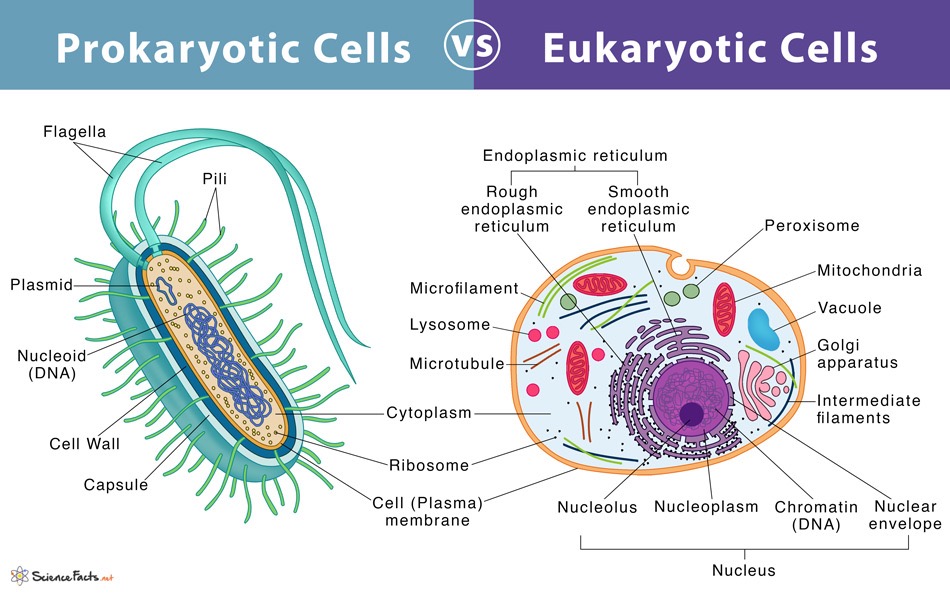
multicellularity
an organism that is composed of many cells that interact and cooperate to perform functions.
there are three general requirements for complex multicellular life: cells must stick together (adhesion), they must communicate with one another, and they must participate in a network of genetic interactions that regulates cell division and differentiation.
once these elements are in place, the stage is set for the evolution of the specialized tissues and organs observed in plants, animals, and other complex multicellular organisms.
in summary, look for
cell growth and division
cell communication
cell specialization
cell-cell adhesion
what are other names for cell division?
mitosis and meiosis (goes through two cycles)
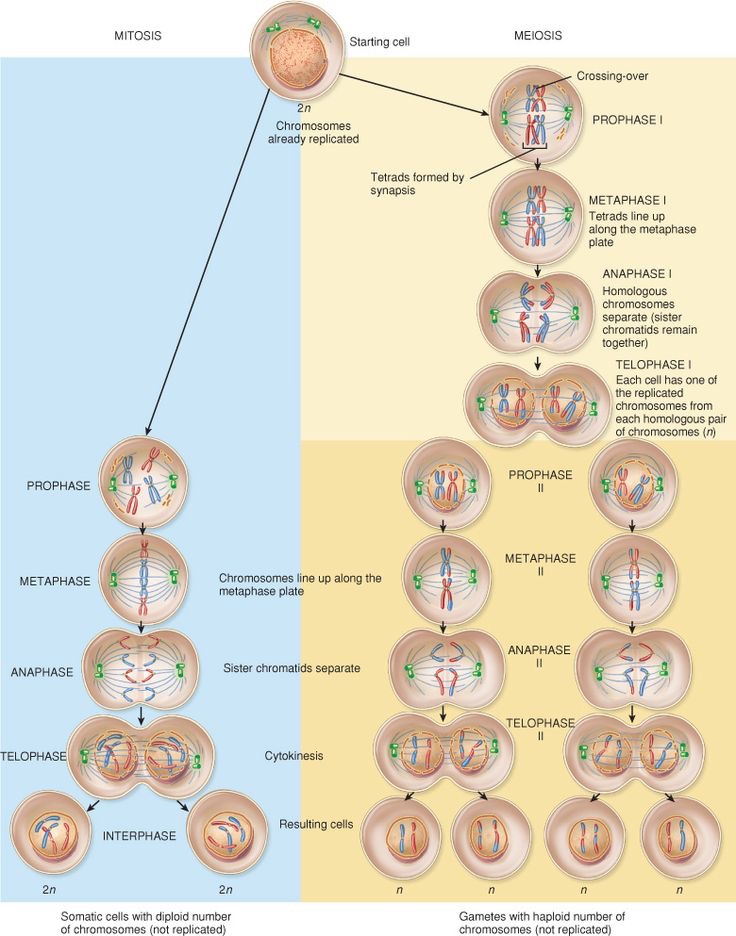
differentiation
the process by which cells become specialized in structure and function, allowing them to perform specific roles within an organism.
specialized
cells that have distinct functions and characteristics adapted to their specific roles.
what is the difference between differentiation and specialized?
differentiation is the process by which unspecialized cells develop into specialized cells, while specialized cells are the end result of this process, possessing distinct functions and characteristics.
adhesion
the process by which cells stick to each other or to their extracellular matrix, playing a crucial role in tissue structure and function.
reminder*
complex multicellularity requires adhesion between cells.
In more context, If a fertilized egg is to develop into a complex multicellular organism, it must divide many times, and the cells produced from those divisions must stick together. In addition, they must retain a specific spatial relationship with one another for the developing organism to function properly
this process illustrates the importance of adhesion in maintaining the organization and integrity of developing tissues in a multicellular organism.
important*
without adhesion there can be no complex multicellularity, and different groups of eukaryotes have evolved distinct types of molecular “glue” for this purpose.
extracellular matrix
a complex network of proteins and carbohydrates that provides structural and biochemical support to surrounding cells, influencing their behavior and function.
the extracellular matrix (ECM) is located outside of cells, in the spaces between them within tissues and organs
proliferating cells
cells that are actively dividing and increasing in number, typically during growth or tissue repair, making it essential for wound healing and the regeneration of tissues.
These cells commonly become organized into sheets of cells called epithelia that line the inside and cover the outside of the body
proliferating cells utilize plasmodesmata in plants and gap junctions in animals to communicate
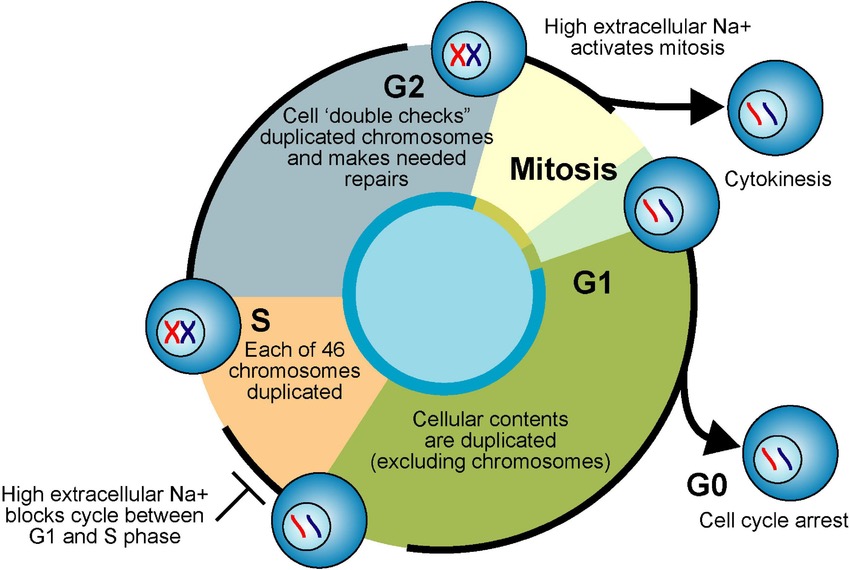
epithelia (specialized tissue)
sheets of cells that line surfaces and cavities throughout the body, providing protection, absorption, and secretion(release).
within epithelia, adjacent cells adhere to each other through transmembrane proteins, especially cadherins, which form molecular attachments between cells.
epithelial cells also secrete an extracellular matrix called the basal lamina, made of proteins and glycoproteins, and these cells attach themselves to this matrix by means of other transmembrane proteins called integrins.
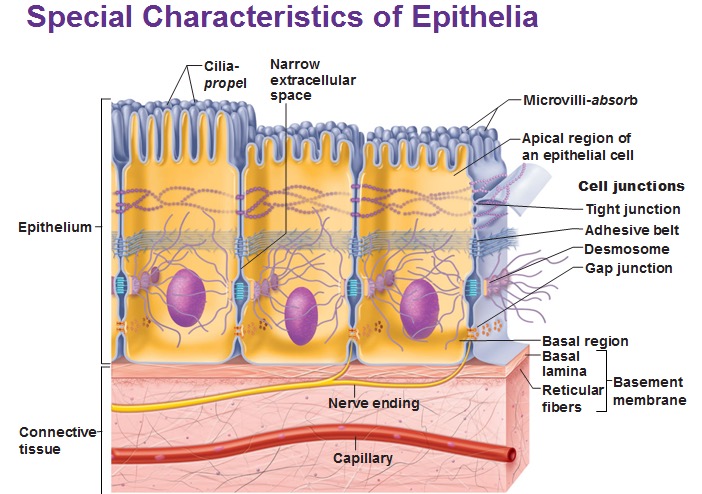
adjacent cells
communicate through direct contact signaling, allowing for immediate response and coordination.
these signals include gap junctions and cell adhesion molecules.
how does the role of adjacent and proliferating cells differ in animal and in pants?
In animals, adjacent cells primarily interact through direct contact signaling to maintain tissue architecture, while proliferating cells are responsible for growth and repair.
In plants, adjacent cells also communicate through plasmodesmata for coordination, while proliferating cells contribute to growth via meristematic tissues.
transmembrane proteins
proteins that span the entire cell membrane, facilitating communication and adherence between cells.
how many different type of transmembrane proteins are there?
There are several different types, including ion channels, receptors, and transporters, each serving specific functions in cellular communication and transport.
cadherins
are a type of transmembrane protein that plays a key role in cell adhesion, forming strong junctions between adjacent cells in epithelial tissues.
reminder*
cadherins do not exist in complex multicellular organisms other than animals, but all such organisms require some means of keeping their cells stuck together
the book does talk about an exception species called “choanoflagellates”
what are cell junctions?
structures that connect cells, facilitating communication and stability between them.
There are three main types: tight junctions, desmosomes junctions, and gap junctions, each serving distinct roles in maintaining tissue integrity and communication.
tight junctions
are specialized connections between adjacent epithelial cells that create a barrier to prevent the passage of molecules and ions through the space between cells, thus maintaining distinct cell environments.
they play a crucial role in maintaining the polarity of epithelial cells and regulating paracellular transport.
thus, tight junctions create a barrier to maintain distinct cell environments
desmosome junction
are cell structures that provide mechanical strength by anchoring adjacent cells together, allowing tissues to withstand stretching and shear forces.
gap junctions
are intercellular channels that allow for direct communication between adjacent cells by permitting the passage of ions and small molecules. They are crucial for synchronizing cellular activities and coordinating responses in tissues.
thus, gap junctions facilitate the communication and transport of ions between cells
basal lamina
a thin layer of extracellular matrix that lies underneath epithelial cells and serves as a support structure, separating them from underlying connective tissue.
It is important for tissue organization, cell adhesion, and influencing cell behavior.
Integrins
are transmembrane proteins that facilitate cell-extracellular matrix adhesion, playing a crucial role in cell signaling, survival, and migration.
Integrins are located in the cell membrane and interact with the extracellular matrix components.
reminder*
integrins do not exist in complex multicellular organisms other than animals, but all such organisms require some means of keeping their cells stuck together
polysaccharides
are long chains of carbohydrate molecules that consist of repeated monosaccharide units. They serve various roles in energy storage, structural support, and cell recognition.
plants also synthesize cell adhesion molecules that bind cells into tissues, but, in this case, the molecules are polysaccharides called pectins
thus, polysaccharides play a role in cell adhesion, tissue structure, and organization in plants, functioning similarly to integrins in animals.
are polysaccharides and pectins the same?
polysaccharides are a broad category of carbohydrates made up of repeated monosaccharide units, while pectins are specific types of polysaccharides that are found in plant cell walls and play a key role in cell adhesion and tissue structure.
choanoflagellates (a species)
are unicellular or colonial eukaryotes that are considered the closest living relatives of animals, possessing a flagellum surrounded by a collar of microvilli, which helps them capture food particles from the water.
important*
the function of the multicellular structures in these choanoflagellates has not yet been determined, but they’re are several observations that support hypothesis like that they aid predation.
unicellular
organisms consisting of a single cell that performs all necessary biological functions.
prokaryotic are only made up of unicellular cells)
cell communication
the process by which cells send and receive signals (molecular signal) to coordinate their functions and activities.
signal molecules
are chemical substances used in cell communication to transmit information between cells, influencing their behavior and activity.
important*
a signaling molecule synthesized by one cell binds with a receptor protein on the surface of a second cell, essentially flipping a molecular switch that activates or represses enzymes or gene expression in the receptor cell’s nucleus
what are the types of signal molecules?
there are several types of signal molecules, including hormones, neurotransmitters, and cytokines, each playing a crucial role in cell communication and regulation.
hormones
chemical messengers that regulate physiological processes in the body, secreted by endocrine glands and transported in the bloodstream.
they help maintain homeostasis, influencing growth, metabolism, and mood.
neurotransmitters
are chemical messengers that transmit signals across synapses from one neuron to another in the nervous system, influencing various physiological processes.
cytokines
are a broad category of signaling molecules that mediate and regulate immunity, inflammation, and hematopoiesis. they are produced by various cells and act on other cells to influence their behavior and function.
hormone imbalance
refers to an abnormality in hormone levels that can disrupt normal bodily functions, leading to various health issues such as fatigue, weight gain, or mood disturbances.
what are the categories of hormones levels?
include steriod, peptide, and amine hormones.
anytime these are at irregular levels there is a hormone imbalance occurring.
what are estrogen and progesterone
estrogen and progesterone are steroid hormones primarily produced by the ovaries that regulate reproductive processes, including the menstrual cycle, pregnancy, and secondary sexual characteristics.
receptors
are proteins that bind hormones and initiate cellular responses.
important*
a signaling molecule synthesized by one cell binds with a receptor protein on the surface of a second cell, essentially flipping a molecular switch that activates or represses enzymes or gene expression in the receptor cell’s nucleus
what are the types of receptors?
there are several types of hormone receptors, including membrane receptors (for peptide and amine hormones) and intracellular receptors (for steroid hormones) that mediate physiological responses.
what are the types of signaling pathways
there are two main types of signaling pathways: extracellular and intracellular pathways, which include various mechanisms such as G-protein coupled receptors, ion channel receptors, and steroid hormone pathways that regulate cellular functions.
these pathways transmit signals from one cell to another, influencing processes like metabolism and gene expression.
extracellular
pathways involve signals that act outside the cell, typically utilizing cell surface receptors to communicate with intracellular signaling mechanisms.
intracellular
pathways involve signals that act within the cell, often through the activation of specific genes or enzymes.
enzymes
biological catalysts that accelerate chemical reactions within cells, often regulated by various signaling pathways.
they can be proteins or RNA molecules that lower the activation energy required for reactions.
what are the types of enzymes?
types of enzymes include kinases, phosphatases, and ligases, each with distinct roles in biochemical reactions and cellular regulation.
kinase
a type of enzyme that catalyzes the transfer of a phosphate group from ATP to a specific substrate, playing a crucial role in signaling pathways and regulating cellular processes.
adds a phosphate group to proteins or other molecules.
reminder*
both plants and animals have the receptor kinase type, and these initiate similar signaling pathways within the cell
phosphatase
is an enzyme that removes a phosphate group from a substrate, often counteracting the action of kinases and regulating various cellular processes.
removes a phosphate group from substrates.
ligases
are enzymes that join two molecules together by forming a new bond, often with the accompanying hydrolysis of ATP.
phosphates
are functional groups consisting of a phosphorus atom bonded to four oxygen atoms, important in energy transfer and signaling within cells.
transmembrane receptors
are proteins that span the cell membrane, allowing communication between the extracellular environment and the interior of the cell.
how do transmembrane receptors connect to transmembrane proteins and cell signaling?
Transmembrane receptors interact with transmembrane proteins to relay signals from outside the cell to the inside, activating intracellular pathways and responses.
important"*
all cells have transmembrane receptors that respond to signals from the environment.
what are the type of receptors?
Types of receptors include G-protein coupled receptors (GPCRs), ion channel receptors, and kinase-linked receptors (KTS), each playing a crucial role in signal transduction.
These receptors detect specific molecules and initiate cellular responses.
Important*
they are types of membrane proteins that transmit signals from the extracellular environment to the inside of the cell, facilitating communication and cellular responses.
Is cell signaling and molecule signaling different?
cell signaling refers broadly to the processes by which cells communicate and respond to signaling molecules, while molecule signaling specifically addresses the role and function of individual signaling molecules in these processes.
cell signaling
is the process by which cells communicate with each other and respond to their environment through signaling molecules and pathways.
involves the general principles of cell communication, including how cells send and receive signals and how a cell responds after it receives a signal (the basic structure it follows is the diagram)
signaling also involves receptor activation, signal transduction, response, and termination.
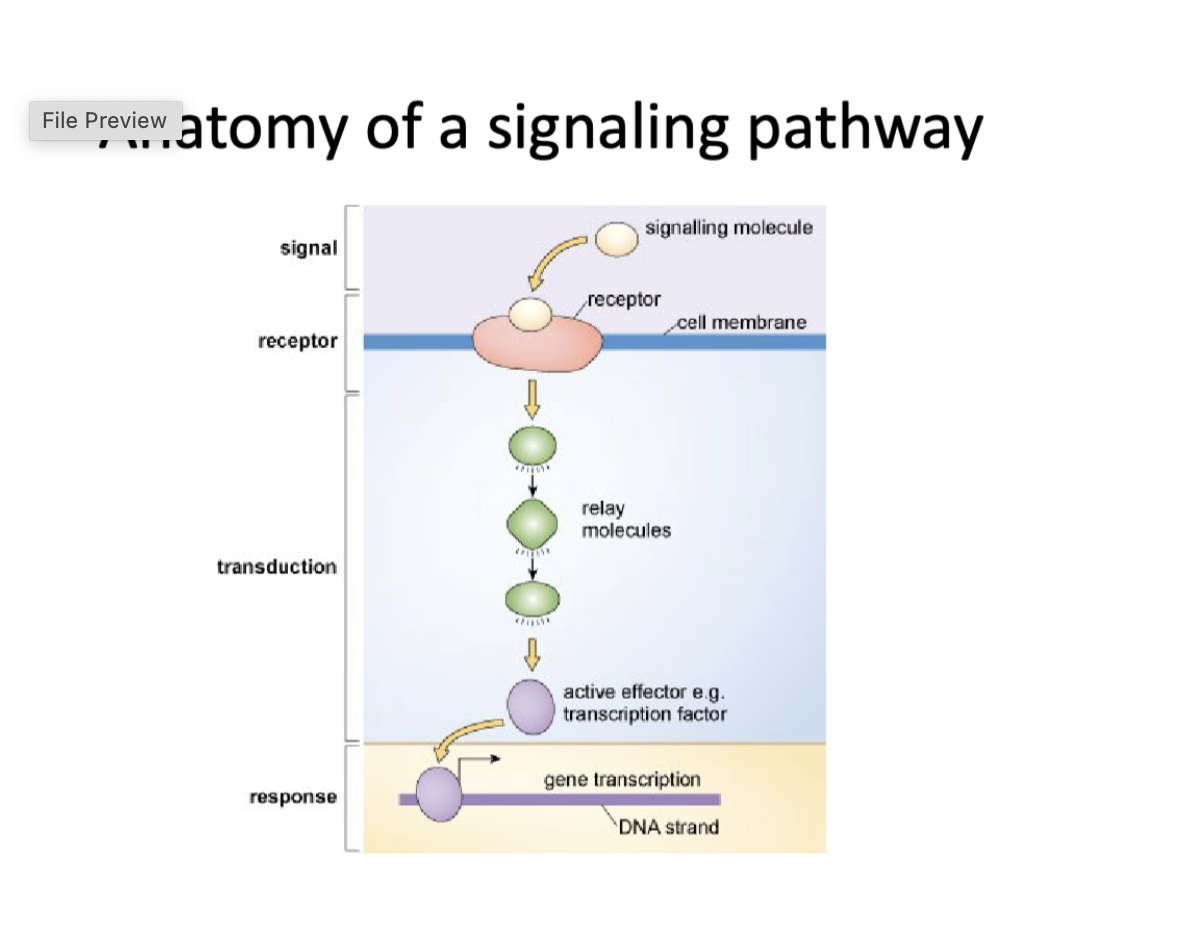
what are the types of cell signaling?
The types of cell signaling include autocrine, paracrine, endocrine, and direct contact signaling.
autocrine cell signals
are signals that influence the same cells that secrete them, playing a crucial role in local cellular communication.
thus, autocrine signals affect the same cells that produce them
paracrine cell signals
are signals that affect nearby cells, facilitating communication over short distances in a tissue.
endocrine cell signals
are signals that travel through the bloodstream to reach and influence distant target cells, crucial for long-distance signaling in the body.
what are the types of channels?
These are protein pores or tunnels that allow ions and small molecules to pass across the cell membrane.
Ion channels: These are specialized channels that allow the passage of specific ions, such as sodium, potassium, or calcium, across the membrane.
important*
additionally, channel types can be classified based on their gating mechanisms, such as voltage-gated, ligand-gated, and mechanically-gated channels.
what do cell junctions receptors and channels have in common?
cell junctions, receptors, and channels all facilitate communication between cells, but they do so in different ways. Cell junctions are structures that connect cells directly, while receptors are proteins that bind to specific signaling molecules, and channels are protein pores that allow the passage of ions and molecules across the cell membrane
why are tight and desmosome junctions not found in plants?
because they lack cell adhesion structures similar to animals, where tight junctions prevent leakage and desmosomes provide mechanical strength.
instead plants have plasmodesmata that serve as channels for communication and transport between cells.
cytoplasm
the gel-like substance within a cell, containing organelles and cytosol, where many cellular processes occur.
Important*
plants, in contrast, have an intrinsic barrier to intercellular communication: the cell wall- has tiny holes (called tubules) in which thin strands of cytoplasm extend from one cell to the next (called plasmodesmata)
plasmodesmata
are channels between plant cells that facilitate direct communication and transport of substances.
(does the job a junction does for animals, except it’s a channel and for plants)
these intercellular channels are lined by extensions of the cell membrane that connect the cytoplasm of adjacent cells, allowing for the movement of water, nutrients, and signaling molecules.
reminder*
complex red and brown algae also have plasmodesmata, and complex fungi have pores between cells that enable cytoplasm that carries signals to flow between cells, which is significant since similar channels do not occur in most unicellular and simple multicellular eukaryotes, they appear to represent an important step in the evolution of complex multicellularity.
endoplasmic reticulum
a network of membranous tubules and sacs within the cytoplasm, involved in protein and lipid synthesis, and calcium storage.
(tubules of endoplasmic reticulum)
receptor protein
a type of protein located on the cell membrane or within the cell that binds to specific signaling molecules, initiating a cellular response.
receptor proteins play a critical role in cell communication by detecting hormones, neurotransmitters, or other signaling molecules, triggering a cascade of biochemical reactions within the cell.
Important*
The signaling molecule binds to a receptor protein on or in the responding cell; in turn, the responding cell changes its activity or behavior.
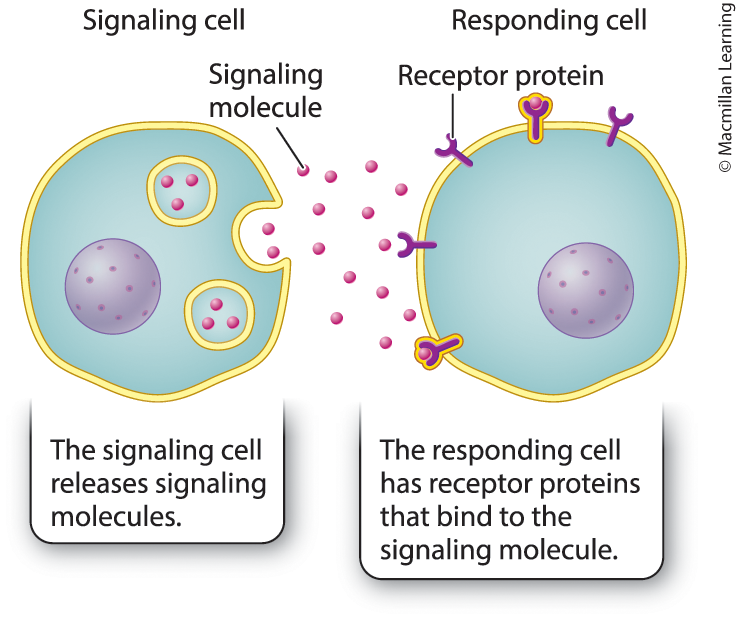
responding cell
a cell that reacts to the binding of signaling molecules to receptor proteins, leading to a change in its activity or behavior.
Important*
shows the four elements required for cellular communication are a signaling cell, a signaling molecule, a receptor protein, and a responding cell
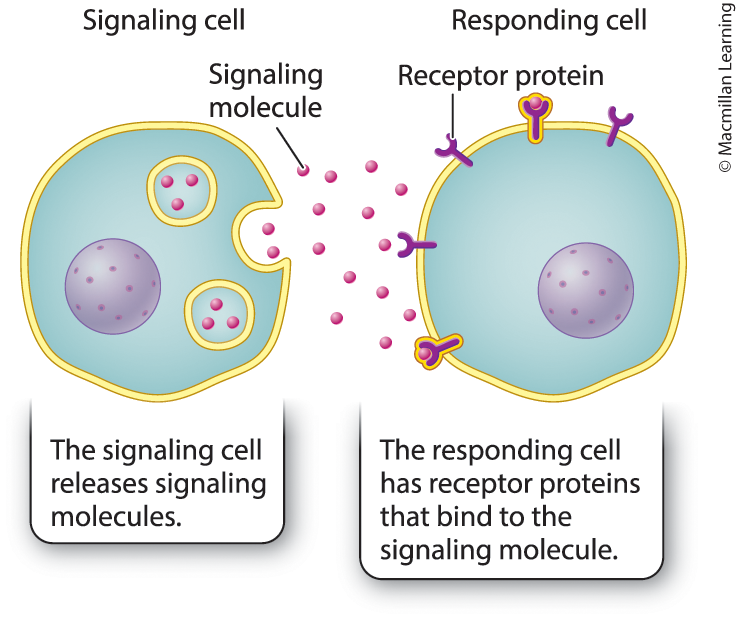
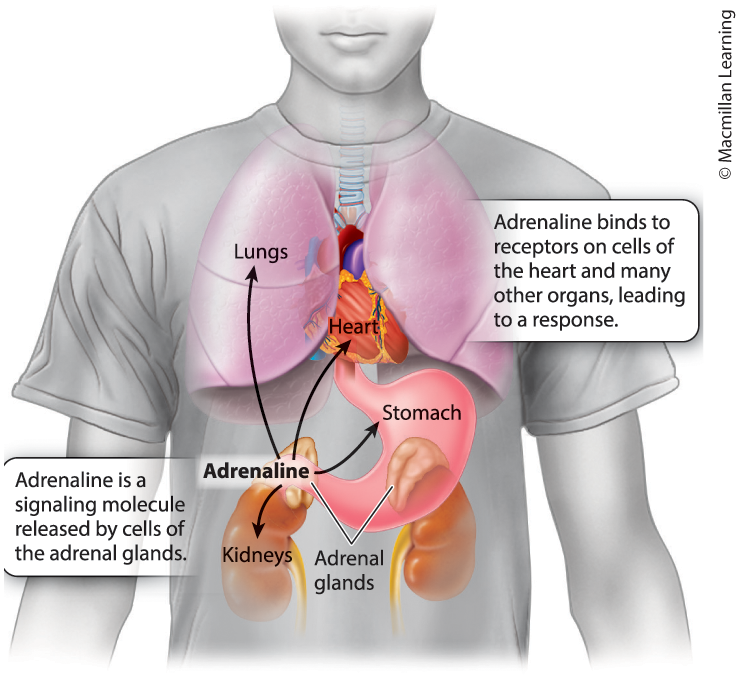
Fight or Flight
a physiological response to stress or perceived danger that prepares the body to either confront or flee from a threat. This response includes increased heart rate, heightened senses, and energy mobilization.
In context*
For these changes to occur, a signaling molecule must travel from signaling cells to responding cells in the heart, lungs, stomach, and many other organs.
The signaling molecule is the hormone adrenaline (also called epinephrine). In response to stress, adrenaline is released from the adrenal glands, located above the kidneys. Adrenaline circulates through the body and acts on many types of cells, including the cells of your heart, causing it to beat more strongly and quickly. As a result, the heart is able to deliver oxygen more effectively to the body
quorum sensing
a process by which bacteria communicate and coordinate their behavior based on population density, often involving the release and detection of signaling molecules like peptides.
density
a measure of mass per unit volume, indicating how much matter is contained in a given space.
Important*
It turns out that they are able to communicate this information to one another through the release of a small peptide.
the binding of this peptide to its receptor causes a bacterium (prokaryotic organism) to express the genes required for DNA uptake. When the bacteria are present at a low density, the peptide is at too low a concentration to bind to receptors on the bacteria.
as the population density of the bacteria increases, so does the concentration of the peptide, until it reaches a level high enough that the peptide binds to receptors to cause the bacteria to turn on genes necessary for DNA uptake
peptide
a short chain of amino acids linked by peptide bonds, often serving as signaling molecules in biological processes.
receptor activation
The “turning on” of a receptor, which often occurs when a signaling molecule binds to a receptor on a responding cell
Important*
as a result of binding to the signaling molecule, some receptors bind to and activate other proteins located inside the cell.
other receptors are enzymes, and binding of a signaling molecule changes the shape and activity of the enzyme.
other receptors are channels in the cell membrane that open or close in response to the binding of a signaling molecule

signal transduction
the process by which a cell converts an external signal into a functional response, often involving receptor activation and intracellular signaling pathways.
Important*
during signal transduction, one molecule activates the next molecule, which activates the next, and so on. In this way, signal transduction can be thought of as a chain reaction or cascade of biochemical events set off by the binding and activation of the receptor.
an important aspect of signal transduction is that the signal is often amplified at each step in the pathway. As a result, a low signal concentration can have a large effect on the responding cell
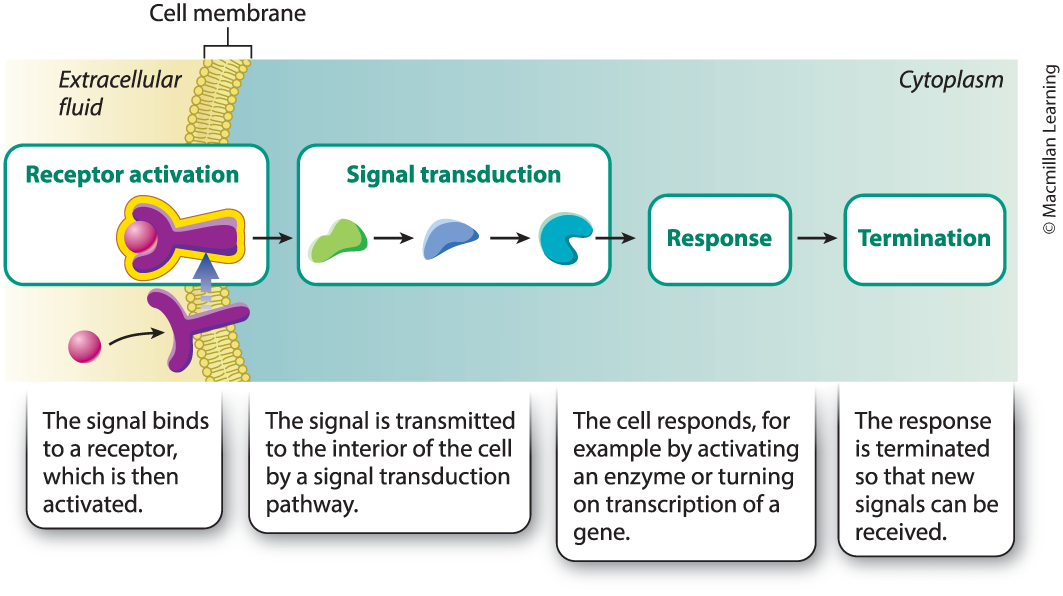
cellular response
the change in cell activity or behavior resulting from signal transduction, often leading to physiological effects. It can take different forms depending on the nature of the signaling molecule and the type of responding cell.
For example, signaling pathways can activate enzymes involved in metabolic pathways or turn on genes that cause the cell to divide, change shape, or signal other cells
Important*
a cell responds to a signal only if it has receptors that are able to bind to the signaling molecule. If specific receptors are present, binding of a signaling molecule leads to downstream effects; if specific receptors are not present, the cell is not able to respond.
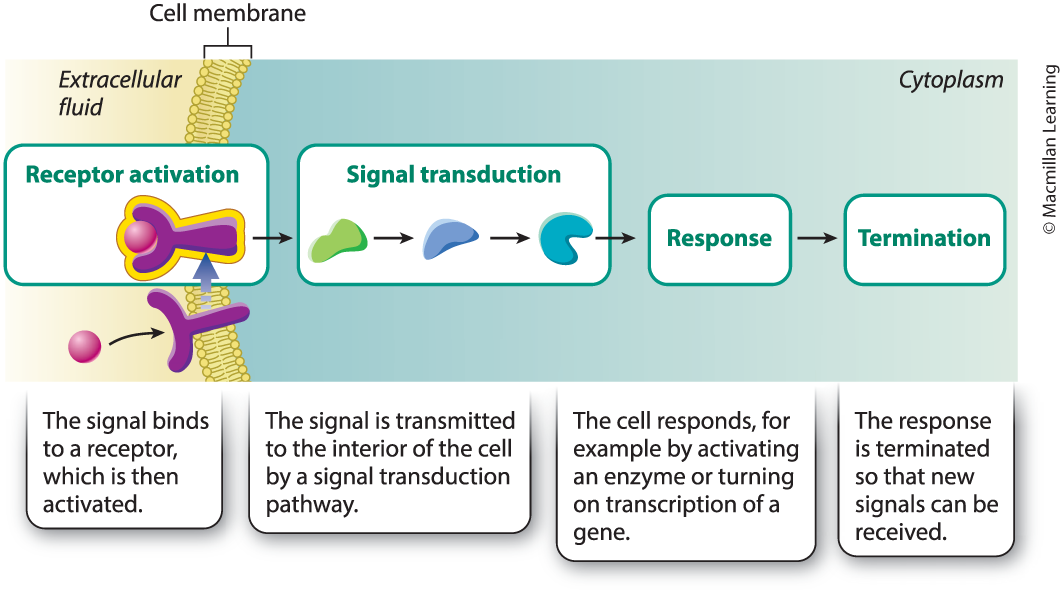
termination
the process by which a signaling pathway is ended, ensuring that the response is appropriately regulated and stops when it is no longer needed.
Important*
the cellular response can be terminated at any point along the signaling pathway.
Termination protects the cell from overreacting to existing signals, thereby holding the cellular response to an appropriate level. Termination also frees up the cell to allow it to respond to new signals
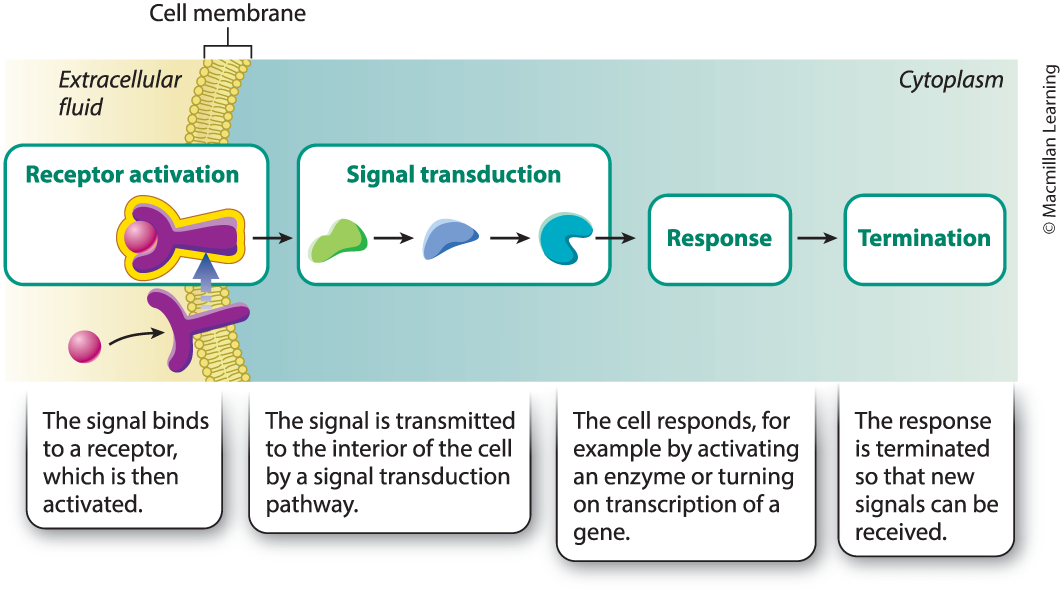
distance between cells
In prokaryotes and unicellular eukaryotes, cell communication occurs between individual organisms. In complex multicellular eukaryotes, cell communication occurs between cells within the same organism.
the same principles of cell communication apply in both instances although, In multicellular organisms, the distance between communicating cells varies considerably.
when the two cells are far apart, the signaling molecule is transported by the circulatory system. When the two cells are close, the signaling molecule simply moves by diffusion. In addition, many cells in multicellular organisms are physically attached to one another, in which case the signaling molecule is not released from the signaling cell at all.
diffusion
the process by which molecules intermingle as a result of their kinetic energy of random motion, moving from areas of higher concentration to areas of lower concentration.